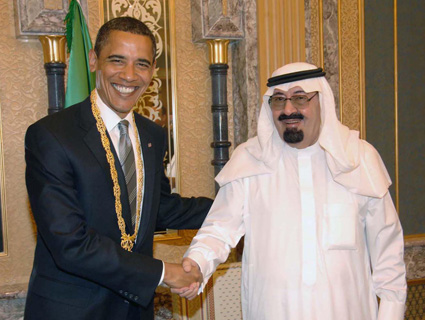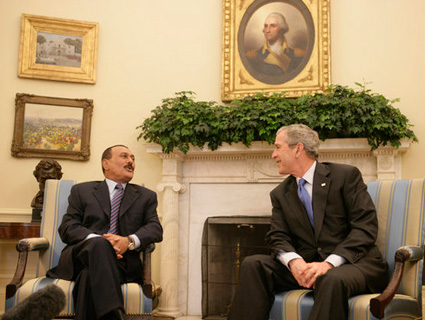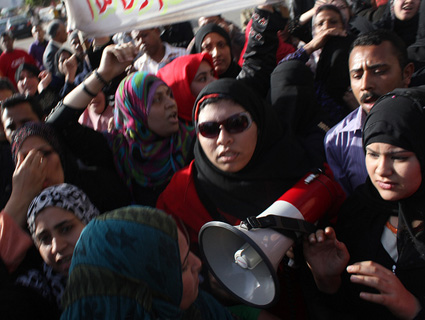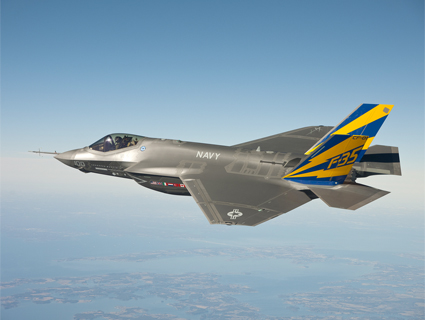
Li Zhen/Xinhua/Zuma
![]() This story first appeared on the TomDispatch website.
This story first appeared on the TomDispatch website.
If you follow the words, one Middle East comes into view; if you follow the weapons, quite another.
This week, the words will take center stage. On Thursday, according to administration officials, President Obama will “reset” American policy in the Middle East with a major address offering a comprehensive look at the Arab Spring, “a unified theory about the popular uprisings from Tunisia to Bahrain,” and possibly a new administration approach to the region.
In the meantime, all signs indicate that the Pentagon will quietly maintain antithetical policies, just as it has throughout the Obama years. Barring an unprecedented and almost inconceivable policy shift, it will continue to broker lucrative deals to send weapons systems and military equipment to Arab despots. Nothing indicates that it will be deterred from its course, whatever the president says, which means that Barack Obama’s reset rhetoric is unlikely to translate into meaningful policy change in the region.
For months now, the world has watched as protesters have taken to the streets across the Middle East to demand a greater say in their lives. In Tunisia and Egypt, they toppled decades-old dictatorships. In Bahrain and Yemen, they were shot down in the streets as they demanded democracy. In the United Arab Emirates, Kuwait, Jordan and Saudi Arabia, they called for reforms, free speech, and basic rights, and ended up bloodied and often in jail cells. In Iraq, they protested a lack of food and jobs, and in response got bullets and beatings.
As the world watched, trained eyes couldn’t help noticing something startling about the tools of repression in those countries. The armored personnel carriers, tanks, and helicopters used to intimidate or even kill peaceful protesters were often American models.
For decades, the US has provided military aid, facilitated the sale of weaponry, and transferred vast quantities of arms to a host of Middle Eastern despots. Arming Arab autocrats, however, isn’t only the work of presidents past. A TomDispatch analysis of Pentagon documents finds that the Obama administration has sought to send billions of dollars in weapons systems—from advanced helicopters to fighter jets—to the very regimes that have beaten, jailed, and killed pro-democracy demonstrators, journalists, and reform activists throughout the Arab Spring.
The administration’s abiding support for the militaries of repressive regimes calls into question the president’s rhetoric about change. The arms deals of recent years also shed light on the shadowy, mutually supportive relationships among the US military, top arms dealers, and Arab states that are of increasing importance to the Pentagon.
Since the summer of 2009, President Obama, by way of the Pentagon and with State Department approval, has regularly notified Congress of his intent to sell advanced weaponry to governments across the Middle East, including Bahrain, Egypt, Iraq, Jordan, Kuwait, Saudi Arabia, Tunisia, and the United Arab Emirates (UAE). Under US law, Congress then has 30 days to review the sale before the Pentagon and associated military contractors enter into more formal contract talks with individual nations.
In July 2009, according to an analysis of Pentagon documents by TomDispatch, notifications were sent to Congress regarding the sale to Kuwait of Browning machine guns, advanced targeting systems for armored vehicles, KC-130 aircraft, and technical support for F/A-18 attack aircraft. Later that summer, the White House announced plans to outfit both Bahrain’s and Jordan’s militaries with advanced air-to-air missiles to the tune of $74 million and $131 million, respectively, to equip the United Arab Emirates with $526 million worth of Hellfire missiles and other materiel, to send more than $2 billion worth of advanced surveillance and navigation equipment to aid Saudi Arabia’s air force, and to see to it that Egypt’s military received a shipment of new Chinook troop transport helicopters and other high-tech equipment valued at $308 million.
In the fall of 2009, Pentagon documents show a $220 million bid by the administration to outfit the Jordanian military with advanced rocket systems and tactical vehicles, a proposed sale of advanced fighter aircraft, parts, weapons, and equipment to Egypt worth as much as $3.2 billion, and another to equip Kuwait’s military with $410 million in Patriot missile technology. Then, in November and December of that year, Congress was notified of plans to sell helicopters to Iraq, Javelin guided missiles to Jordan, Hellfire missiles, anti-ship cruise missiles, jet engines, and other military materiel to Egypt, and helicopters and thousands of advanced bombs, among other high-tech equipment, to the UAE.
Last year, notifications also went out concerning the sale of F-16 fighters, armored personnel carriers, tank ammunition, and advanced computer systems to Iraq, C-17 military transport aircraft for Kuwait, mobile missile systems for Bahrain, and Apache attack helicopters and tactical missile systems for the United Arab Emirates. Saudi Arabia, however, was the big winner by far with a blockbuster $60 billion agreement for helicopters, fighter jets, radar equipment, and advanced smart bombs that will represent, if all purchases are made, the largest foreign arms deal in American history.
Deficits, Ducats, and Dictators
The agreement to broker the sale of tens of billions of dollars worth of weapons to Saudi Arabia sheds light on the Pentagon’s efforts to shield itself—and its favored arms dealers—from the shakiness of the American economy, as well as President Obama’s stated goal of trimming $400 billion from projected national security spending of $10 trillion over the next 12 years. Last October, the Pentagon started secretly lobbying financial analysts and large institutional investors on behalf of weapons makers and other military contractors. The idea was to bolster their long-term financial viability in the face of a possible future slowdown in Defense Department spending.
 Since then, Deputy Secretary of Defense William Lynn and other Pentagon powerbrokers have made regular trips to New York City to shore up Wall Street’s support for weapons manufacturers. “We are in this for the long term. We need industrial partners and financial backers who think and act likewise,” Lynn told investors at a recent defense and aerospace conference in that city.
Since then, Deputy Secretary of Defense William Lynn and other Pentagon powerbrokers have made regular trips to New York City to shore up Wall Street’s support for weapons manufacturers. “We are in this for the long term. We need industrial partners and financial backers who think and act likewise,” Lynn told investors at a recent defense and aerospace conference in that city.
Along with Ashton Carter, the Pentagon’s undersecretary of defense for acquisition, technology, and logistics, and Brett Lambert, the deputy assistant secretary for industrial policy, Lynn is creating a comprehensive plan to sustain and enrich weapons makers and other military contractors in the coming years. “We’re going sector by sector, tier by tier, and our goal is to develop a long-term policy to protect that base as we slow defense spending,” Lynn said. America’s Middle Eastern allies are seen as a significant partner in this effort.
It’s often said that the Pentagon is a “monopsony”—that is, the only buyer in town for its many giant contractors. As has been amply demonstrated since Barack Obama took office, however, it’s not true. When it comes to the Middle East, the Pentagon acts not as a buyer, but as a broker and shill, clearing the way for its Middle Eastern partners to buy some of the world’s most advanced weaponry.
And Arab allies have distinctly done their part for the Pentagon. From 2006 to 2009, according to a report by the Congressional Research Service issued late last year, the United States accounted for 52.4% of all arms agreements inked with Middle Eastern nations—to the tune of $47.3 billion. (By comparison, the United Kingdom, in second place in arms sales in the region, accounted for only 15.7% and third-place Russia just 12.8%.)
The purchases of the chief buyer in the Middle East, Saudi Arabia, have been climbing steadily. From 2002 to 2005, Saudi Arabia inked $15.3 billion in arms-transfer agreements with the United States. From 2006 to 2009, that figure jumped to $29.5 billion. The multi-year $60 billion deal in 2010 signaled far more of the same and will help ensure the continuing health and profitability of Boeing, Lockheed-Martin, and other mega-defense contractors even if Pentagon spending goes slack or begins to shrink in the years to come.
The Pentagon’s reliance on the deep pockets of Arab partners across the Middle East, however, has a price, which may help to explain the Obama administration’s willingness to support dictators like Tunisia’s Zine El Abidine Ben Ali and Egypt’s Hosni Mubarak until their ousters were givens, and to essentially look the other way as security forces in Bahrain, Saudi Arabia, Yemen, and elsewhere, sometimes using American-supplied equipment, suppressed pro-democracy activists. After all, the six member states of the Gulf Cooperation Council—Bahrain, Kuwait, Oman, Qatar, Saudi Arabia, and the UAE, along with regional partner Jordan—are set to spend $70 billion on American weaponry and equipment this year, and as much as $80 billion per year by 2015.
“The Middle East Military Air Market: Revenue Opportunities and Stakeholder Mapping,” a recent analysis of just one sector of defense spending in the region by US-based defense consultants Frost and Sullivan, projects yet more growth in the future. “[The] regional military air market is… set to generate revenues of $62.9 billion between 2010 and 2020,” it reports. Frost and Sullivan analysts add that Saudi Arabia and the United Arab Emirates are likely to be the biggest spenders and will continue to buy most of their arms through the United States for the sake of “political influence.”
For his part, Deputy Secretary of Defense Lynn wants to make it ever easier to put sophisticated military technology in the hands of such deep-pocketed allies. On his recent trip to New York, he spoke of streamlining the process by which tanks, jets, and other advanced weapons systems are sold around the world. “To keep our base healthy, it is in our interest for defense companies to compete globally,” he explained, while deriding the current system for selling arms abroad as “archaic” and in need of an overhaul. “The barriers that we place at this point in the export control system look something like a marriage of the complexity of the Internal Revenue Service with the efficiency of the Department of Motor Vehicles,” he said. “It’s something we have to change.”
Sending a Message
In February, in Baghdad, Fallujah, Mosul, and Tikrit, Iraqi protesters took to the streets, focused on ending corruption and chronic shortages of food, water, electricity, and jobs. In response, Prime Minister Nuri al-Maliki, who has in recent years consolidated power with US military backing, unleashed government security forces. They arrested, beat, and shot protesters, leaving hundreds dead or wounded. In the weeks since, the Obama administration has not only failed to forcefully rebuke the Maliki regime, but has announced its intent to bolster those same security forces with another $360 million in military materiel ranging from radios to radar systems.
In March, the United Arab Emirates sent security forces into neighboring Bahrain to help put down pro-democracy protests. Early the next month, UAE security forces disappeared leading human rights activist Ahmed Mansoor and, in the days thereafter, detained at least four other prominent democracy activists. Before the month was out, however, the Obama administration announced its intention to arm the UAE with advanced Sidewinder tactical missiles.
Saudi Arabia also sent troops into Bahrain and has been cracking down on nonviolent activists at home with increasing vigor. At the beginning of this month, for example, Human Rights Watch reported the arrest of “at least 20 peaceful protesters, including two bloggers.” Within days, the Obama administration notified Congress of its intent to see the Saudi security forces receive $330 million worth of advanced night vision and thermal-imaging equipment.
This year, US-coordinated arms sales have resulted in the delivery of helicopter gunships to Yemen, navy patrol boats to Iraq, and the first of six cargo aircraft to the UAE. At the moment, used armored personnel carriers are being refurbished for shipment to Iraq later this year.
Whatever “reset” may be in the works for Obama administration policies in the Middle East, the president and the Pentagon are already on the record. Since 2009, they have sought to arm some of the most anti-democratic regimes on the planet, while repeatedly highlighting the need for democratic reform and now for a fresh start in the region. Even as the “reset” begins, the Pentagon is leaning ever more heavily on rich rulers in the Arab world to prop up the military-corporate complex at home. If the Pentagon and the weapons makers have their way, the provisional successes of the demonstrators in Egypt and Tunisia will turn out to be outliers as an Arab Spring turns distinctly wintry.
In June 2009, President Obama traveled to Cairo University to give a heavily hyped and much-lauded speech (“On a New Beginning“) to “the Muslim world.” In his remarks, the president spoke of an American Cold-War-era attitude “in which Muslim-majority countries were too often treated as proxies without regard to their own aspirations.” Then came his first call for a reset of sorts in the region. “I’ve come here to Cairo,” he said, “to seek a new beginning between the United States and Muslims around the world, one based on mutual interest and mutual respect.” Before that summer was out, however, Obama notified Congress of his intent to send Cold War-era autocrat Hosni Mubarak a shipment of new helicopters to beef up his security forces.
During that speech, Obama talked of his “unyielding belief” that all people yearned for free speech, a say in their governance, the rule of law, freedom from corruption, and other basic civil liberties. These weren’t, the president insisted, just American ideals, they were human rights. “And that is why we will support them everywhere,” he said to waves of applause.
In its actions, however, the Obama administration almost immediately left its reset rhetoric in the dust. Whether the president does any better in the Arab Summer of 2011 will depend mightily on whether he can stand up to the Pentagon and its weapons-makers.
Nick Turse is a historian, essayist, investigative journalist, the associate editor of TomDispatch.com, and currently a fellow at Harvard University’s Radcliffe Institute. His latest book is The Case for Withdrawal from Afghanistan (Verso Books). You can follow him on Twitter @NickTurse, on Tumblr, and on Facebook. This piece is part of Turse’s ongoing coverage on US military impacts on the Arab Spring and the third in his TomDispatch series on the subject. To stay on top of important articles like these, sign up to receive the latest updates from TomDispatch.com here.















